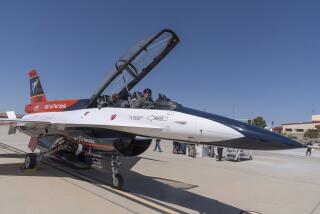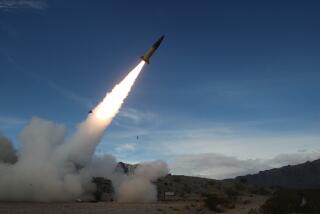Almost All U.S. Airstrikes Involve ‘Smart’ Bombs
- Share via
WASHINGTON — The bombing campaign over Yugoslavia has opened a new era in which virtually every bomb dropped from a U.S. warplane is a “smart” weapon with a high-technology guidance system.
Almost 30 years after smart weapons came on the scene during the Vietnam War, the Pentagon is now using such guided bombs for nearly 100% of its strikes, officials said Monday.
And though they can still go awry--as was tragically demonstrated last week in an errant strike on a Serbian apartment complex--these weapons have given air power a whole new meaning compared with the one it had in World War II, when bombardiers would sometimes entirely miss their targeted cities.
“They’ve completely changed the nature of warfare,” said Kenneth H. Bacon, the chief Pentagon spokesman.
In the Persian Gulf War of 1991--despite the impression left by the military’s flashy video footage--only 9% of munitions were smart weapons. By 1995, when the U.S. and its North Atlantic Treaty Organization allies undertook a three-week air campaign against the Serbs of Bosnia-Herzegovina, 70% of the bombs were guided munitions.
“This time, we’re fighting the war that people thought we were fighting nine years ago,” said John Pike, a military analyst at the Federation of American Scientists, an arms control advocacy group in Washington.
Pentagon briefers have been showing off the capabilities of these smart weapons since the campaign began 20 days ago.
In recent days, for example, they showed an army barracks in Yugoslavia that had been flattened while buildings standing only yards away were untouched.
The headquarters of the Yugoslav security police bureaucracy in Belgrade was blasted, though there was a hospital a block away that was virtually unscathed.
The majority of the smart weapons in the U.S. inventory are laser-guided bombs that have a major defect: They can be thrown off by bad weather. This has been a considerable disadvantage in the current Balkan campaign, because of regular cloud cover and fog.
But the next generation of munitions, the satellite-guided variety, will correct that, experts promise.
Most of the smart munitions in the inventory today--about 60,000 of them--are laser-guided bombs. These weapons are essentially “dumb” metal bombs of years past, except for two differences: They have laser seekers on their noses and small movable winglets on their tails.
In an airstrike, an aircraft pilot, wingman or ground controller aims a laser at the target. The laser seeker picks up that directional signal; the fins are automatically adjusted to guide the bomb in that direction.
The system can generally bring the bomb within four yards of the target--provided the laser remains fixed on the target during flight.
But if clouds or fog deflect the laser, the bomb may go in an entirely wrong direction, as happened last week, when a bomb flattened two residential areas in the small Serbian coal-mining town of Aleksinac, killing as many as 20 civilians. “They’re fair-weather friends,” Pike said.
When the weather has been bad, NATO forces have relied on satellite-guided munitions.
At the top end of the price list, these include the $1-million Tomahawk cruise missiles fired from U.S. and British ships in the Adriatic and the Conventional Land Attack Cruise Missiles fired from B-52 bombers.
But also in the inventory is a new class of less expensive munitions, which are essentially dumb bombs equipped with satellite guidance systems. In this campaign, the B-2 bomber has delivered the so-called JDAMs, or Joint Direct Attack Munitions, which reach their targets following directional signals bounced off satellites.
The Pentagon is making a huge investment in this kind of munitions, hoping to avoid the kind of slowdowns forced by the weather in Operation Allied Force.
The satellite guidance technology is also less expensive than the laser-guided systems. It costs about $50,000 to upgrade a dumb bomb with a laser-guidance “kit” but only about $18,000 to upgrade with the satellite guidance equipment.
Some dumb bombs will probably remain in the inventory, such as the cluster munitions that release hundreds of pieces of shrapnel to kill troops and destroy vehicles.
But analysts say past wars would have been far different with the advantages of the latest generation of munitions.
“Think how World War II might have been different if we could have focused on the headquarters of the Gestapo and SS,” Pike said.
(BEGIN TEXT OF INFOBOX / INFOGRAPHIC)
2 Types of Precision Attacks
Though laser-guided bombs remain the most numerous precision weapons in the U.S. arsenal, the Pentagon is turning more to global positioning munitions, which are less dependent on clear weather. Laser weapons require a clear line of sight that is not possible in bad weather.
Sources: Federation of American Scientists, Defense Department, Associated Press
More to Read
Sign up for Essential California
The most important California stories and recommendations in your inbox every morning.
You may occasionally receive promotional content from the Los Angeles Times.











